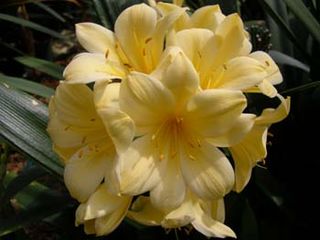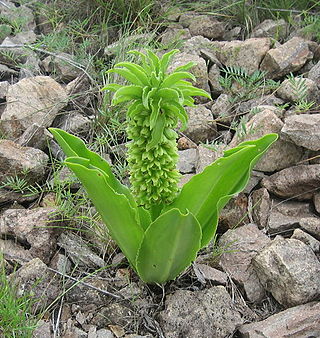
Amaryllis is the only genus in the subtribe Amaryllidinae. It is a small genus of flowering bulbs, with two species. The better known of the two, Amaryllis belladonna, is a native of the Western Cape region of South Africa, particularly the rocky southwest area between the Olifants River Valley and Knysna.

In botany, a bulb is structurally a short stem with fleshy leaves or leaf bases that function as food storage organs during dormancy.

Narcissus is a genus of predominantly spring flowering perennial plants of the amaryllis family, Amaryllidaceae. Various common names including daffodil, narcissus, and jonquil are used to describe all or some members of the genus. Narcissus has conspicuous flowers with six petal-like tepals surmounted by a cup- or trumpet-shaped corona. The flowers are generally white and yellow, with either uniform or contrasting coloured tepals and corona.

The lily family, Liliaceae, consists of about 15 genera and 610 species of flowering plants within the order Liliales. They are monocotyledonous, perennial, herbaceous, often bulbous geophytes. Plants in this family have evolved with a fair amount of morphological diversity despite genetic similarity. Common characteristics include large flowers with parts arranged in threes: with six colored or patterned petaloid tepals arranged in two whorls, six stamens and a superior ovary. The leaves are linear in shape, with their veins usually arranged parallel to the edges, single and arranged alternating on the stem, or in a rosette at the base. Most species are grown from bulbs, although some have rhizomes. First described in 1789, the lily family became a paraphyletic "catch-all" (wastebasket) group of lilioid monocots that did not fit into other families and included a great number of genera now included in other families and in some cases in other orders. Consequently, many sources and descriptions labelled "Liliaceae" deal with the broader sense of the family.

Clivia is a genus of monocot flowering plants native to southern Africa. They are from the family Amaryllidaceae, subfamily Amaryllidoideae. Common names are Natal lily or bush lily.

Crinum is a genus of about 180 species of perennial plants that have large showy flowers on leafless stems, and develop from bulbs. They are found in seasonally moist areas, including marshes, swamps, depressions and along the sides of streams and lakes in tropical and subtropical areas worldwide.

Amaryllis belladonna, the Jersey lily, belladonna-lily, naked-lady-lily, or March lily, is a plant species native to Cape Province in South Africa but widely cultivated as an ornamental. It is reportedly naturalized in many places: Corsica, Portugal, the Azores, Madeira, the Canary Islands, the Scilly Isles of Great Britain, the Democratic Republic of the Congo, Ascension Island, Australia, New Zealand, Mexico, Cuba, Haiti, the Dominican Republic, Chile, California, Texas, Louisiana, Mississippi, and the Juan Fernández Islands.

Nerine is a genus of flowering plants belonging to the family Amaryllidaceae, subfamily Amaryllidoideae. They are bulbous perennials, some evergreen, associated with rocky and arid habitats. They bear spherical umbels of lily-like flowers in shades from white through pink to crimson. In the case of deciduous species, the flowers may appear on naked stems before the leaves develop. Native to South Africa, there are about 20–30 species in the genus. Though described as lilies, they are not significantly related to the true lilies (Liliaceae), but more closely resemble their relatives, Amaryllis and Lycoris. The genus was established by the Revd. William Herbert in 1820.

Crinum pedunculatum also known as the swamp lily, river lily or mangrove lily, is a bulbous perennial found in stream and tidal areas of the Northern Territory, Queensland and New South Wales, Australia as well as New Guinea and some Pacific Islands. It is unclear whether it is native or introduced to Norfolk Island.

Lycorine is a toxic crystalline alkaloid found in various Amaryllidaceae species, such as the cultivated bush lily, surprise lilies (Lycoris), and daffodils (Narcissus). It may be highly poisonous, or even lethal, when ingested in certain quantities. Regardless, it is sometimes used medicinally, a reason why some groups may harvest the very popular Clivia miniata.

Zephyranthes carinata, commonly known as the rosepink zephyr lily or pink rain lily, is a perennial flowering plant native to Mexico, Colombia and Central America. It is also widely cultivated as an ornamental and naturalized in the West Indies, Peru, Argentina, Brazil, the southeastern United States from Texas to Florida, Zimbabwe, South Africa, China, Korea, the Ryukyu Islands, Assam, Nepal, Bhutan, Sri Lanka, Solomon Islands, Queensland, Society Islands, Kiribati, and Caroline Islands.

Zephyranthes robusta, synonym Habranthus robustus, commonly known as the Brazilian copperlily, pink fairy lily or the pink rain lily, is a species of herbaceous flowering bulb. It is native to Brazil, Argentina and Uruguay, but is now naturalized in Florida, Colombia, South Africa, and Mauritius.

Crinum asiaticum, commonly known as poison bulb, giant crinum lily, grand crinum lily, or spider lily, is a plant species widely planted in many warmer regions as an ornamental. It is a bulb-forming perennial producing an umbel of large, showy flowers that are prized by gardeners. However, all parts of the plant are poisonous if ingested. Some reports indicate exposure to the sap may cause skin irritation.

Eucomis autumnalis, the autumn pineapple flower, or autumn pineapple lily, is a species of flowering plant in the family Asparagaceae, subfamily Scilloideae, native to Malawi, Zimbabwe and southern Africa. It is a mid to late summer flowering deciduous bulbous perennial. The flower stem reaches about 40 cm (16 in), rising from a basal rosette of wavy-edged leaves. The green, yellow or white flowers are arranged in a spike (raceme), topped by a "head" of green leaflike bracts. It is grown as an ornamental garden plant and can also be used as a cut flower.

Lycoris radiata, known as the red spider lily, red magic lily, corpse flower, or equinox flower, is a plant in the amaryllis family, Amaryllidaceae, subfamily Amaryllidoideae. Originally from China, Japan, Korea and Nepal and from there to the United States and elsewhere. It is considered naturalized in Seychelles and in the Ryukyu Islands. It flowers in the late summer or autumn, often in response to heavy rainfall. The common name hurricane lily refers to this characteristic, as do other common names, such as resurrection lily; these may be used for the genus as a whole.

Ornamental bulbous plants, often called ornamental bulbs or just bulbs in gardening and horticulture, are herbaceous perennials grown for ornamental purposes, which have underground or near ground storage organs. Botanists distinguish between true bulbs, corms, rhizomes, tubers and tuberous roots, any of which may be termed "bulbs" in horticulture. Bulb species usually lose their upper parts during adverse conditions such as summer drought and heat or winter cold. The bulb's storage organs contain moisture and nutrients that are used to survive these adverse conditions in a dormant state. When conditions become favourable the reserves sustain a new growth cycle. In addition, bulbs permit vegetative or asexual multiplication in these species. Ornamental bulbs are used in parks and gardens and as cut flowers.

Nerine bowdenii is a species of flowering plant in the family Amaryllidaceae. It is an herbaceous bulbous perennial, growing to 45 cm (18 in) tall by 8 cm (3 in), with strap-shaped leaves and large umbels of lily-like pink flowers in late summer and autumn. The common names of the species are Cornish lily, Cape flower, Guernsey lily, and Bowden lily. However, it is neither a true lily nor from Cornwall or Guernsey, but originates from South Africa. Confusingly the name “Guernsey lily” is also applied to a related species, Nerine sarniensis.

Boophone disticha is a bulbous tropical and subtropical flowering plant, endemic to Africa. Commonly called the century plant or tumbleweed, Boophone disticha was first collected in 1781 from South Africa by Swedish botanist Carl Peter Thunberg and described by Carl Linnaeus as Amaryllis disticha. Since that time it has been placed in the genera Brunsvigia and Haemanthus, finally coming to rest as Boophone. The genus itself was written in three ways by the author William Herbert, straining the procedures of the rules of nomenclature. The etymology of the genus is from the Greek bous = ox, and phontes= killer of, a clear warning that eating the plant can be fatal to livestock.

Leucojum aestivum, commonly called summer snowflake or Loddon lily, is a plant species widely cultivated as an ornamental. It is native to most of Europe from Spain and Ireland to Ukraine, with the exception of Scandinavia, Russia, Belarus and the Baltic countries. It is also considered native to Turkey, Iran and the Caucasus. It is naturalized in Denmark, South Australia, New South Wales, Nova Scotia and much of the eastern United States.




















